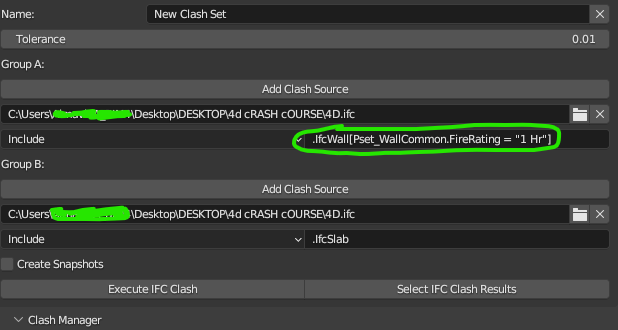@Moult said:
The numbering seems odd, I'm assuming it's arbitrary based on what clusters of coordinates it finds. Maybe a simple heuristic of the IFC class element with the largest bounding box can be used to give it a name, which would make it more recognisable?
You are right, currently the numbering of the groups is the raw output from the clustering algorithm, but doesn't relate to anything in the model. Renaming the groups based on the IFC class could get tricky since theoretically there could be dozens of objects of different classes in the same group.
I think for now I will just give them unique names / ids that can be retraced and later when some prioritization algorithm is added it we could use that as a input for the name.
One gaping feature in IFC Clash is that it doesn't output BCF. Outputting this in BCF would be preferred (I can show you the existing code for this in the add-on, as well as the BCF lib that is used) - which can then be brought into Blender for viz, or even another app - you can run IFC Clash from the cloud and spit out a BCF.
Agreed, automating the drudgery of grouping clashes and converting them into actionable coordination issues is the ultimate goal.
I hope I got the right Twitter handle! I have also posted this on LinkedIn.
You got the right one!
@Cyril said:
Ability to define rule to ignore clash based on a common attribute (eg. MEP system).
I believe this is already doable with the clash selector syntax (I could be wrong... @Moult ?). In any case, I agree this should be a feature one way or another.
Ability to automatically define severity of clashes based on what type of object are clashing (eg. a little overlap on maintenance space is not always so bad, an overlap between 2 insulation is less important than 2 overlap between 2 ducts/pipes).
This is a huge one and probably the most difficult to solve to everyone's satisfaction. However, it is my objective with this add-on. I think that by combining good "standardized" input clash-sets with a prioritization algorithm that can be intuitively understood (and maybe even adjusted) by the user, we could quickly have something that helps us sort through large clash sets much quicker than anything on the market today.
Question : does it still use python-fcl ?
Yes, at this point I'm only grouping the clashes that result from the code already in BlenderBIM.
I've created a Trello board to track the progress of the Smart Clash Manager: https://trello.com/b/U8ul1w3q/blenderbim-smart-clash-manager-roadmap
